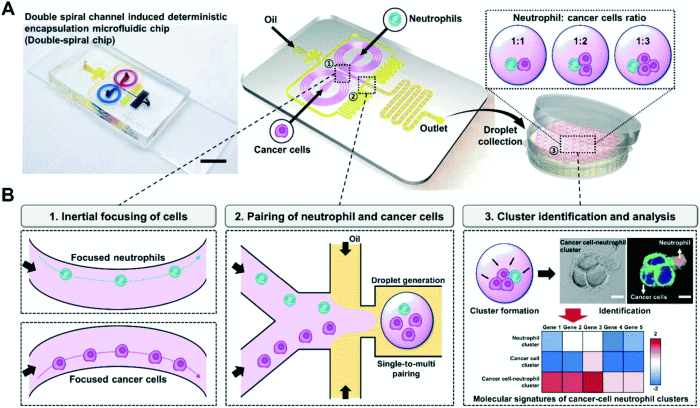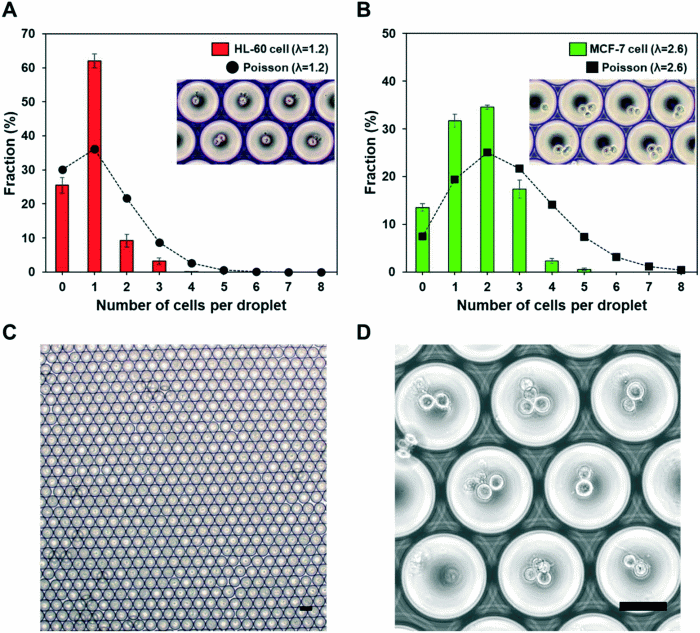
30 Jul Droplet microfluidic and inertial microfluidic unite to enable CTC-cluster study
Circulating tumor cell (CTC) clusters have higher potential for extravasation and have been shown to have elevated metastatic potential than single CTCs that can reach up to 100-fold. CTC-neutrophil clusters are composed of single neutrophils and cancer cells with a pairing ratio from 1:1 to 1:3. These clusters can incorporate upregulated genes leading to being one of the highest metastatic precursors. The extravasation tendency makes CTC clusters in the bloodstream even rarer than single CTCs which in turn makes isolation and studying these clusters extremely difficult. In vitro models, however, can help us gain a better understanding of cluster formation, metastasis through vascular adhesion, etc. Microfluidic technology offers a wide range of tools for encapsulation/isolation of cells as well as a controlled environment for cell culture.
This week’s research highlight covers a microfluidic advancement developed by a research team at Yonsei University, Seoul, Republic of Korea. The team combines an inertial microfluidic approach with droplet microfluidics to study a special type of CTC clusters namely CTC-neutrophil clusters.
“Here, we introduce an inertial-force-assisted droplet microfluidic chip that allows the recapitulation of CTC–neutrophil clusters in terms of physical as well as biochemical features. The deterministic encapsulation of cells via double spiral channels facilitates the pairing of neutrophils and cancer cells with ratios of interest (from 1 : 1 to 1 : 3).”, the authors explained.

Reproduced from J. Park, S. Park, K. A. Hyun and H. Jung, Lab Chip, 2021, Advance Article, DOI: 10.1039/D1LC00433F with permission from Royal Society of Chemistry.
It is essential to have control over the cluster combination since the majority of the CTC-neutrophil clusters contain 2-4 cells only which makes conventional methods nearly impractical for forming these clusters. Droplet microfluidics, on the other hand, holds tremendous potential for handling and maintaining cells. However, a major challenge here would be the Poisson statistics which predicts randomly distributed cells to be randomly encapsulated in the droplets. To overcome this challenge, the research team took advantage of inertial microfluidics to align the cancer cells and neutrophils before encapsulation. The proposed microfluidic device for CTC–neutrophil clusters study was microfabricated with PDMS, one of the most commonly used materials for microfluidic chips, and combined a flow-focusing droplet generator device with two spiral channels. The inertial focusing add-on forces the cell to line a single streamline and facilitates sequential encapsulation of the cells with ratios of 1:1 to 1:3 in the droplets.

Reproduced from J. Park, S. Park, K. A. Hyun and H. Jung, Lab Chip, 2021, Advance Article, DOI: 10.1039/D1LC00433F with permission from Royal Society of Chemistry.
It was shown that the microfluidic chip was capable of forming in-vitro CTC-neutrophil clusters and was validated by determining the molecular feature expression of the clusters.
“To summarize, these findings demonstrate that the pairing of cancer cells and neutrophils realized via our chip can provide an informative in vitro model for understanding the complex interactions between heterogeneous cancer cells and immune cells.”
Read the original article: Microfluidic recapitulation of circulating tumor cell–neutrophil clusters via double spiral channel-induced deterministic encapsulation

Pouriya Bayat
Pouriya is a microfluidic production engineer at uFluidix. He received his B.Sc. and M.A.Sc. both in Mechanical Engineering from Isfahan University of Technology and York University, respectively. During his master's studies, he had the chance to learn the foundations of microfluidic technology at ACUTE Lab where he focused on designing microfluidic platforms for cell washing and isolation. Upon graduation, he joined uFluidix to even further enjoy designing, manufacturing, and experimenting with microfluidic chips. In his free time, you might find him reading a psychology/philosophy/fantasy book while refilling his coffee every half an hour. Is there a must-read book in your mind, do not hesitate to hit him up with your to-read list.


